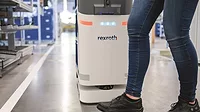Boosting CPG competitiveness with universal automation
Fast implementations and agile operations differentiate next-generation food, beverage and life sciences firms.

Photo courtesy of Getty Images/credit vgajic
As the consumer-packaged goods (CPG) industry accelerates in the digital era, rapidly changing and less predictable consumer behavior is redefining how competitive advantage is established and maintained. Food and beverage and life sciences firms are finding new ways to:
- Quickly alter production lines in response to abrupt supply chain disruptions.
- Rapidly reduce SKUs to control costs when certain products are supply constrained.
- Exponentially grow access to data to better trace and document product and process end-to-end lifecycles.
Some of these leading-edge firms are also building and rolling out universal automation-based production infrastructure solutions to drastically reduce their time to market.
How CPG stakeholders successfully deal with these digital age challenges will, in large part, depend on two critical elements:
- The reinvention of “business as usual” approaches to production
- An ability to rapidly adapt technology innovation.
Universal automation: an app store of “plug and produce” solutions
A fundamental building block for addressing these production and innovation challenges is a technology concept referred to as universal automation. The notion of universal automation implies a world of “plug and produce” automation software components (think of it as the dawn of an industrial app store). In this world, hardware is decoupled from software to create portable and interoperable software-centric industrial automation systems. These systems are capable of unleashing next generation advancements across the full operational lifecycle.
For decades, CPG stakeholders have had to work within the constraints of the long-standing proprietary automation systems they have inherited. They have often had to choose one supplier with whom they could coexist, even though more innovative process-related systems and machines might be sourced from disparate suppliers. Universal automation removes these historical constraints and now allows industrial platforms to be built on more open, data-driven architectures.
“Digital-first” industrial enterprises and smart factories using universal automation can now attain step-change increases in efficiency, reliability, productivity, and sustainability from safe and secure operations that easily adapt to market changes and customer demands.
Based on standards, ready to go mainstream
An existing standard, IEC 61499, serves as a key enabler of universal automation. The standard allows software applications to be designed independently of the hardware platform. As a result, end users, machine builders, systems integrators and application developers now have the flexibility to operate in unprecedented ways, driving never-before-seen levels of efficiency and productivity.
In addition, companies that are strong advocates of open systems have begun developing and releasing new products based on the IEC 61499 standard. EcoStruxure Automation Expert, for example, is designed to enable concepts such as zero re-engineering, virtual commissioning, IT/OT convergence and digital services in multiple ways, providing CPG firms with:
Increased flexibility. Since software is no longer tied to the hardware, manufactures can easily adapt their automation infrastructure to ever-changing supply and demand-side business conditions. If productivity numbers need to be stepped up, the choice of possible technology-solution choices is wider, and integration costs of those new tools are much lower.
Open engineering philosophy. Since object-oriented programming approaches are central to the IEC 61499 standard, models of business assets can be easily manipulated by engineers to accommodate preferred methods of control. The automation application is designed to connect directly to pre-built, ready-to-use asset models. This enables an open engineering philosophy and strategy that centres around user experience and process improvement, rather than on system technology constraints. By placing the process at the centre of the engineering universe, plants attain the operational phase faster, with lower costs and fewer risks.
Cost-effective implementations. Rather than having to build and purchase IT/OT gateways, users benefit from embedded native IT/OT integration. This simplifies engineer, plant operator, systems integrator, and machine builder system deployment workloads. In addition to reducing new system deployment time and cost, this universal automation system also facilitates a “wrap and re-use” approach for existing systems, preserving millions of dollars in prior end-user investments.
For more information, visit Schneider Electric.
Looking for a reprint of this article?
From high-res PDFs to custom plaques, order your copy today!





